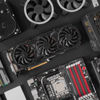
Our work on Design for Circularity (DfC) helps uncover obstacles to be addressed:
- Trend-driven designs, poor focus on functional lifespan and rapid upgrades lead to quick obsolescence, promoting disposal instead of longevity.
- Products designed without modularity, sealed, and non-replaceable components limit opportunities to reuse, repair, or remanufacture.
- The lack of access to standardized or affordable spare parts makes repairs costly and impractical, discouraging to keep the product in use.
- Insufficient logistics and infrastructure to maintain, transport, and upgrade products limit scalability.










